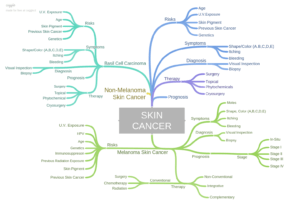Remember A,B,C,D,E When Checking your Body for Possible Skin Cancer. Consider Evidence-based, Non-toxic Therapies to Reduce Your Risk of Skin Cancer-
Checking your skin regularly for possible Non-Melanoma (Basal/Squamous Cell Carcinoma) and Melanoma skin cancer is a great habit to get into. But remember that it is only a first step. Skin cancer is complicated and there are many risks. I’ll use myself as an example…
- I burned regularly as a kid. Often burning badly…(UV Exposure)
- I had warts…(HPV virus)
- Both parents have been diagnosed with non-melanoma skin cancer…(Genetics)
- I had an autologous stem cell transplant for a different cancer (high risk of secondary cancer)
- I underwent radiation therapy for the above mentioned cancer (Radiation Therapy)
- I’m bald (I’m developing faint spots on my head)
Granted, I am an outlier. My point is that when you look back over your entire life you may have more skin cancer risks than you think. U.V. radiation is cumulative.
If after checking your skin regularly you find something that looks suspicious go see a dermatologist who will check you carefully with a dermoscope. Even professionals need the right tools.
To Learn More About Basal Cell Carcinoma- click now
I am both a cancer survivor and cancer coach. Scroll down the page, post a question or comment and I will reply to you ASAP.
David Emerson
- Cancer Survivor
- Cancer Coach
- Director PeopleBeatingCancer
Recommended Reading:

Melanoma at a glance-
- Risks– UV Exposure, HPV, Genetics, Skin Pigment, Moles, Immunosuppression, Previous Skin Cancer Diagnosis,
- Symptoms- Mole, Shape (A,B,C,D,E), Itching, Bleeding,
- Diagnosis- Visual Inspection, Skin Biopsy,
- Prognosis– Staging, In-situ, I, II, III, IV, Five year survival rates
- Therapy– Conventional, Non-Conventional, Integrative, Alternative
3 Most Common Types of SC and How to Identify Them
- “Squamous Cell Carcinoma – Around 20% of skin cancers are due to squamous cell carcinoma. This type of cancer develops on areas of the skin that are regularly exposed to the sun or from another type of skin condition known as actinic keratosis…
- Basal Cell Carcinoma – Basal cell carcinoma is the most common form of cancer in any part of the body. This type of cancer cell does not generally spread to other parts of the body unless it goes unnoticed for a long period of time…
- Melanoma – Melanoma is less common than squamous and basal cell carcinoma, but is much more dangerous due to the speed at which it can spread. Melanoma presents as a black or brown growth on the skin that is often asymmetrical and without a clearly defined border…”
How to Identify SC
It’s important to closely examine your skin for any new or changing moles or growths, and to do so on a regular basis. When checking your body for SC, doctors advise the following ABCDE rule:
1) Asymmetry – Healthy moles should be round and symmetrical.
2) Border – A clearly defined border is common in healthy skin growths and should not be blurred or faded.
3) Color – Pay attention to the color of your moles. Any that contain several shades of black, brown, or blue should be examined by a dermatologist.
4) Diameter – Any moles larger than a ¼ inch in diameter may need to be looked at by a professional.
5) Evolving – If you have a mole or skin growth that is changing in shape, size, or color, make an appointment with a trained dermatologist immediately for further examination.



